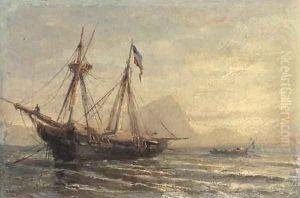Aleksei Petrovich Bogoliubov Paintings
Aleksei Petrovich Bogoliubov was a significant figure in 19th-century Russian art, celebrated for his contributions as a marine painter and educator. Born into an aristocratic family in Pomerania, Russian Empire (now Poland), on March 16, 1824, Bogoliubov's early life was marked by tragedy with the loss of his mother at a young age. Despite this early setback, he showed a strong inclination towards art, nurtured by his surroundings and the cultural milieu of his family. His naval career, initiated by his enrollment in the Naval Cadet Corps, became the bedrock of his artistic specialization, allowing him first-hand experience of the sea and maritime life, which would deeply influence his later works.
After graduating, Bogoliubov served in the Russian Navy, where he traveled extensively, capturing seascapes, ship scenes, and coastal towns. His naval career was a gateway to his artistic development; it was during these voyages that he began to document his travels through sketches and paintings, developing a keen eye for the interplay of light and water, which would become a hallmark of his style. Recognizing his growing passion for art, Bogoliubov resigned from the navy in the 1850s to pursue painting full-time. He then studied at the Imperial Academy of Arts in Saint Petersburg and traveled across Europe, honing his skills and absorbing the influences of Western art movements.
Bogoliubov's works are characterized by their meticulous attention to detail, vibrant portrayal of light, and dynamic compositions. His seascapes not only captured the physical beauty of the sea but also conveyed the moods and drama of maritime life. Beyond his artistic pursuits, Bogoliubov played a crucial role in the development of Russian art education. He was instrumental in the establishment of the Moscow School of Painting, Sculpture, and Architecture, where he also taught, nurturing a new generation of Russian artists.
His legacy is also marked by his philanthropic efforts; he established a scholarship for young artists at the Imperial Academy of Arts and donated his personal collection to the academy, laying the foundation for what would become the Russian Museum in Saint Petersburg. Aleksei Petrovich Bogoliubov died on October 3, 1896, in Paris, France. His works continue to be celebrated for their technical mastery and emotive power, offering a window into the maritime world of the 19th century and contributing significantly to the heritage of Russian art.
